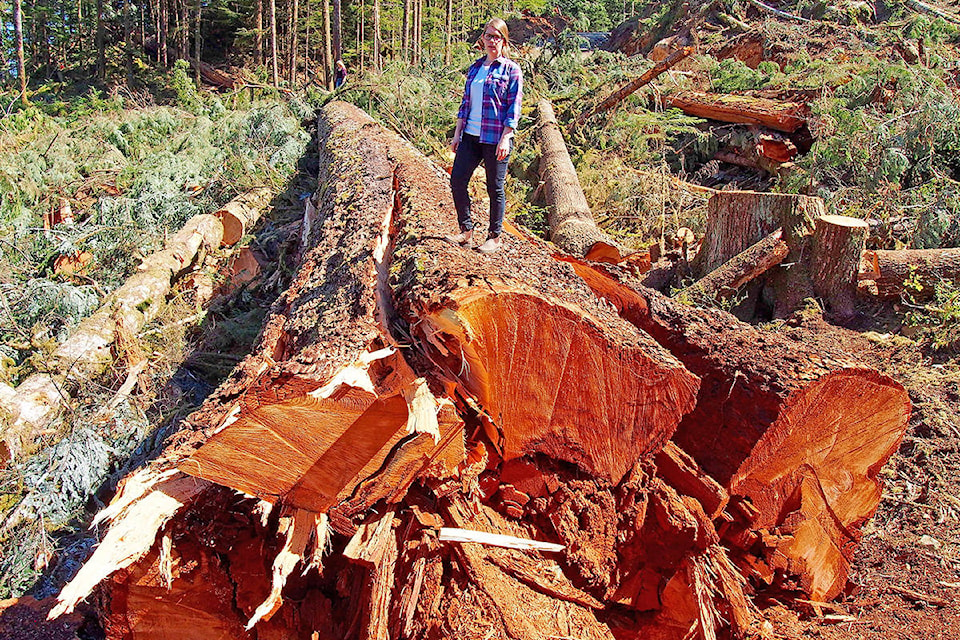BY MIKE YOUDS
Special to the News
B.C. Timber Sales is reviewing its best management practices for legacy trees with the intent of strengthening a policy brought into question by old-growth logging near Port Alberni.
The Crown agency (BCTS) and the B.C. government have been roundly criticized in recent weeks by conservationists and local First Nations for continuing to allow logging of ancient fir and cedar in the Nahmint Valley.
Researchers aligned with the lobby group Ancient Forest Alliance pinpointed the logging last month of what was the ninth largest Douglas fir. They maintain that it’s one of many old-growth giants still being levelled in Vancouver Island forests.
READ: Blame for felled Nahmint giant placed on NDP
“Although it should be a no-brainer to protect B.C.’s biggest trees, what we ultimately need is protection for endangered forest ecosystems, which are under siege by commercial logging. Almost 11,000 hectares of old-growth forests were cut on Vancouver Island in 2016,” said Andrea Inness, an alliance campaigner. “And where better to start protecting old-growth than at the government’s own logging agency, B.C. Timber Sales?”
Immediately west of Port Alberni, the valley contains some of the most extensive stands of old-growth forest on Vancouver Island left standing outside of Clayoquot Sound. The area lies in the territory of Hupacasath and Tseshaht First Nations.
The Crown agency is overseen by the Ministry of Forests, Lands and Natural Resource Operations, which confirmed that the old-growth Douglas fir cited by Ancient Forest Alliance was part of Crown lands auctioned off before new policy was in place.
“With regard to the specific tree mentioned in the (Ancient Forest Alliance) news release, BCTS’ best management practices on legacy trees came into effect after that specific timber sale was laid out,” the ministry stated. “BCTS is also reviewing this policy to make it stronger.”
In its current form, policy requires any Douglas fir wider than 2.1 metres and any cedar wider than three metres to be left standing. The felled Nahmint fir was three metres in diameter.
Since August 2016, BCTS has awarded five timber sales totalling 319 hectares in the valley. The ministry noted, however, that there are 2,760 hectares of old growth protected in the “Nahmint landscape unit.”
BCTS has identified 250 old-growth cedar trees to be spared from logging in the Nahmint, the ministry said. As well, the ministry maintains that old growth forest is not far from a rare commodity on the Island, representing 43 percent of 1.9 million hectares of Crown forest on the Island. A large proportion of that old growth — 520,000 hectares — is protected.
Despite reassurances, conservation groups insist that government is exaggerating the extent of highly productive old growth, specifically trees ranging from 500 to 1,000 years old. Cut blocks in the Nahmint Valley auctioned by BCTS extend into areas where those oldest trees are found and don’t provide enough buffer to retain old-growth ecosystems, the alliance says.
Mike Stini of the Port Alberni Watershed Alliance was among those who identified the fir when it was still standing this spring.
“To see it lying on the ground two weeks later was devastating, especially since these big, old Douglas firs are now endangered after a century of commercial logging,” Stini said. “There are less than one percent of the old-growth Douglas-firs on the coast remaining. It’s like finding a huge black rhino or Siberian tiger that’s been shot. There are simply too few today and logging the last of these giants shouldn’t be allowed to happen anymore in B.C.”
